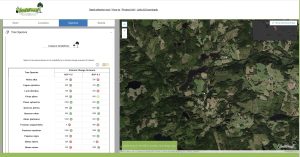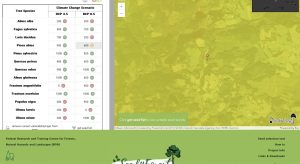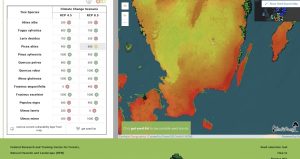Have you ever felt that a little help deciding what to plant after a clear-felling would be desirable? Well, hear this: It’s on the net like everything else. You can visit the doctor and the shrink on the Internet for advice, so why not let it decide what to plant or at least propose something?
Let the net decide what to plant
The service I’m referring to is called Seed4Forest. It’s developed and provided free of charge by the Austrian Federal Research and Training Centre for Forests Natural Hazards and Landscape, BFW(Bundesforschungszentrum für Wald), and is mainly meant for central Europe. However, the tool gives suggestions in all of Europe.
The suggestions you get are presented according to two different climate scenarios:
RCP* 4.5 – describes a scenario with reduced greenhouse gas emissions that may result in a temperature increase of 1,5 – 3 degrees centigrade in Europe by the end of the 21st century.
RCP 8.5 – describes a scenario with increasing greenhouse gas emissions that may result in a temperature increase of 3 – 5 degrees centigrade in Europe by the end of the 21st century.
The suitability is ranged on a scale from 0 to 1000 where low values depict a low probability of occurrence of the species in question.
So, your choice depends on what you believe the climate will be like around 2080 and 2100.
Easy to use
The tool is very easy to use. We recently made a small clear-cut on our family estate in south Sweden so of course I had to try Seed4Forest on that site.
This site contained mainly Norwegian spruce (Picea abies) and has a theoretical annual growth (for spruce) of 11 cubic meters per hectare according to the management plan made by the Swedish Forest Agency in 2017. There was also some aspen (Populus tremula) and oak (Quercus robur) on the site that was not felled.
This is how to do it:
On the start page, you click “Start” and in the next step, you enter the name of the estate where you wish to plant or a close by searchable location. You can scroll and zoom the map to find and click on the exact location. After you have clicked on the location you will get a list of rated suggestions for that site.
(There is also a “How to” page with a very good description in the top menu on the start page)
In the screenshot above you will see the result for our clear-felled site (the red needle). As mentioned above, the scale of suitability is 0 – 1000, But there is also a color indication for the same thing where green represents high values in the scale and red low values. That means that yellow is in the middle of the scale like Picea abies (Norwegian spruce) in the RCP 8.5 scenario.
When clicking on that value, the map shows the suitability of Norwegian spruce in color.
It seems we should try something else for the next generation on that stand.
Should we really have Norwegian spruce in southern Sweden?
A reflection I make here is this: In southern Sweden, Norwegian spruce is the most common species. E.g., our forest land contains 71 percent Norwegian spruce. When I zoom out to cover all of south Sweden it turns obvious that we might have to think about this. Either stop the temperature increase or start growing ash (Fraxinus excelsior), oak (Quercus robur), or elm (Ulmus minor).
Well, that’s another discussion. We should also bear in mind that Seed4Forest is developed mainly for central Europe, and they don’t claim to be the absolute truth. But still – it makes you think …
The fact is that on our estate (the location is marked on the map above) Norwegian spruce is growing very well today and has done so for at least 150 years. Another fact is that ash, oak, birch, aspen, and some other hardwood species grow all over the estate even though we have never planted or sown those species, not during the last 100 years anyway. And yet another fact is that forest maps from the 18th century show that our estate back then was covered with oak forests. These are facts that we know and can verify.
But we don’t know the suitable species for our forest land in 2080 – 2100. We can only guess, and for this kind of guessing Seed4Forest could be one of (hopefully) many tools to use.
*RCP = Representative Concentration Pathway
Photos: Screenshots from Seed4Forest














